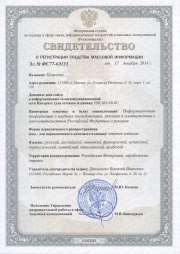MAIN PAGE
> Back to contents
Psychologist
Reference:
Livak N.S., Portnyagina A.M., Tkacheva A.V., Popov V.V., Vladykin I.V.
Formation of a responsible attitude of the children of primary school age to their health
// Psychologist.
2023. ¹ 4.
P. 62-84.
DOI: 10.25136/2409-8701.2023.4.43899 EDN: WBLSPM URL: https://en.nbpublish.com/library_read_article.php?id=43899
Formation of a responsible attitude of the children of primary school age to their health
Livak Nataliya Stepanovna
PhD in Psychology
Associate Professor, Department of Psychology and Pedagogy, Siberian State University of Science and Technology named after Academician M.F. Reshetnev
660037, Russia, Krasnoyarsk, Krasnoyarsk worker, 31

|
livak.nata@mail.ru
|
|
 |
Portnyagina Anastasiya Mikhailovna
Senior Lecturer, Department of Psychology and Pedagogy, Siberian State University of Science and Technology named after Academician M.F. Reshetnev
660037, Russia, Krasnoyarsk, Krasnoyarsk worker , 31

|
anastasy08@mail.ru
|
|
 |
Tkacheva Anna Vladimirovna
Senior Lecturer, Department of Modern Educational Technologies, Siberian Federal University
79 Svobodny Prospekt str., Krasnoyarsk, 660041, Russia

|
aatkacheva@yandex.ru
|
|
 |
Popov Vitalii Vladimirovich
Postgraduate Student, Department of Developmental Psychology and Counseling, Siberian Federal University
79 Svobodny Prospekt str., Krasnoyarsk, 660041, Russia

|
vvpopov@mail.ru
|
|
 |
|
Vladykin Igor' Vil'yamsovich
Postgraduate Student, Department of Developmental Psychology and Counseling, Siberian Federal University
79 Svobodny Prospekt str., Krasnoyarsk, 660041, Russia

|
ivladykin@yandex.ru
|
|
 |
|
DOI: 10.25136/2409-8701.2023.4.43899
EDN: WBLSPM
Received:
25-08-2023
Published:
05-09-2023
Abstract:
Today, children's health problems need new approaches. In this regard, the educational function of teachers and psychologists is important in order to form a child's idea of a healthy lifestyle, to form right attitudes to their's own health. This is of particular importance for young people, children, since they are the future generation that will continue our history, which has determined the relevance of this work related to the formation of a responsible attitude to a healthy lifestyle of children, which is the subject of this work. A psychological and pedagogical program for 4th grade students has been developed to form a responsible attitude to their health and healthy lifestyle. The implementation of the program includes three main levels: 1) Emotional involvement (emotional-value component of a responsible attitude); 2) semantic (cognitive component); activity (activity component). As a result of the implementation of the psychological and pedagogical program, the level of responsible attitude of children to their health has significantly increased. Namely, the number of children with a conscious attitude to their health has increased (cognitive component), the level of mastery of cultural norms has increased (emotional and value component), the number of schoolchildren participating in health-preserving and promoting a healthy lifestyle has increased
Keywords:
attitude, responsible attitude, activity, values, health, junior schoolchildren, health-saving technologies, upbringing, emotional attitude, cognitive component
This article is automatically translated.
You can find original text of the article here.
Relevance. The problem of educating a healthy generation is now becoming increasingly important. The deterioration of health is influenced by many factors, including the wrong attitude of the population to their health and the health of their children [21, 22]. The results of scientific developments (Gulbina S.M. [2], Eremina, Yu.S. [5]) indicate that the situation of a decrease in the level of children's health formed in previous years is becoming permanent today. According to the results of studying the medical documents of younger schoolchildren, data were obtained that many schoolchildren have a decrease in visual impairment – in the first place, the second position is a violation of posture, in the third place is the presence of chronic diseases and a very small number of schoolchildren are considered healthy today. Quite a large number of children attend school with a complex of diseases of the musculoskeletal system. According to official data of the Ministry of Health of the Russian Federation, about 25-30% of Russian children coming to school have some kind of health abnormalities; among school graduates, about 80% cannot be called absolutely healthy (2022). When analyzing pathologies, a large number of children with diseases of the musculoskeletal system are singled out. According to screening studies conducted by specialized schools in Moscow, Novosibirsk, Krasnoyarsk, children and adolescents with geometrically healthy posture make up only 2-3% of the total number of examined. In addition to the high prevalence, another feature of diseases is that these diseases are classified as long-term ongoing processes that accompany all periods of a child's development. With inadequate treatment and progressive course of these diseases, they inevitably lead to disability [1]. According to the results of screening examinations by orthopedic doctors of the boarding school of Krasnoyarsk students in 2022-2023, 1535 students of schools No. 62, 45 of the Sverdlovsk district No. 32 of the Zheleznodorozhny district, school No. 159 of the Oktyabrsky district revealed 357 students without pathologies (53.3%), the rest have posture disorders (54.6%), scoliosis of 1-3 degrees (22.1%). The weakening of the physical well-being of children worries not only doctors, but also teachers. This situation is getting worse every year. To date, children's health problems need new approaches [4, 6]. In this regard, the educational function of teachers and psychologists is important in order to form a child's idea of a healthy lifestyle, to form attitudes to the right approach to their health [1, 3]. This is of particular importance for young people and children, since they are the future generation that will continue our history, which has determined the relevance of this work related to the formation of a responsible attitude to a healthy lifestyle in children [11, 12]. The degree of development of the problem. Responsible attitude to one's health has a social structure by nature, difficult in form and content, and is a concept whose various aspects have been studied by scientists of philosophy, pedagogy, ethics, sociology, psychology and other sciences [19]. The works of P.P. Blonsky, A.Ya. Komensky, A.N. Leontiev, A.S. Makarenko, A.I. Orekhovsky, V.I. Speransky, V.A. Sukhomlinsky, etc. they are a broad methodological basis for the study of this issue. The problem of fostering a healthy lifestyle in children occupies one of the central places in the study of the scientific foundations of children's practical psychology and pedagogy [10, 20]. Scientists today need to revise and radically change plans, programs, and means of teaching a healthy lifestyle, introducing healthy lifestyle culture positions, bringing them into line with the changing socio-economic circumstances of society [7, 9]. Quite a large number of works are devoted to the study of the objective attitude to health as a social value, which is associated with the understanding of a person's social position in society and the attitude to health as a social value. These are the works of Sergeeva B. V. [13], Guruzhapov V. A.[3], Kitaev, V. S.[7] and others. The deterioration of the level of health of schoolchildren is primarily due to such reasons as violation of the regime, violations of sanitary and hygienic standards of education, which is studied by Frumin, I. D. [15], Lipatova, E.V. [16] another reason is the increasing volume of information and load on the student every year, as Oshchepkova T. writes.L. [9], Sevruk A. I. [12]. Abroad, the problem of forming a responsible attitude of schoolchildren to health is studied by Carless D. [16], Cornell J. [17], Cutter-Mackenzie A. [18], etc. The relevance of the chosen topic, its insufficient theoretical and practical elaboration determined the choice of the topic of the dissertation research "Formation of a responsible attitude to the own health of children with disorders of the musculoskeletal system in a general educational institution." The object of the study: The attitude to their health in schoolchildren with disorders of the musculoskeletal system The subject of the study is the formation of a responsible attitude of schoolchildren with disorders of the musculoskeletal system to their health in a general education organization The purpose of the study is to develop and test a psychological and pedagogical program for the formation of a responsible attitude to their health for schoolchildren with a violation of the musculoskeletal system.
Research methods: During the ascertaining stage, the method of determining the general level of formation of a student's health culture authored by N. S. Garkush was used, consisting of three questionnaires, as well as a modified method of "self-assessment of the level of health by students of grades 5-8" authored by E. N. Weiner and E. V. Volynskaya [4]. Each of the questions of the methods is aimed at studying the corresponding component of a responsible attitude to health: 1) emotional-value; 2) semantic (cognitive); activity. In our study, we will rely on the research of B.F. Sergeeva, since she considers not only the cognitive side of the psyche, but also the emotional-volitional [13, 14]. Since the basis of our work was the concept of A. N. Leontiev's activity, the main condition for the formation of a responsible attitude to healthy lifestyle among younger schoolchildren was a specially developed psychological and pedagogical program, which is compiled according to the principles of designing new development situations in the child-adult community. Stages of the study. The study was carried out from 2021 to 2023.: November 2022 – March 2023 - the stage of the ascertaining and control experiment using empirical methods and techniques: questionnaire, conversation, quantitative and qualitative analysis of the results of the study using statistical processing methods. March-June 2023 - development and verification of the effectiveness of the basics of technology for the formation of a responsible attitude to one's own health as a social value. The results of the study. According to the method "Harmony of the lifestyle of schoolchildren" (N.S. Garkusha) – a cognitive component of a responsible attitude to health, the following results were obtained in the control and experimental groups. 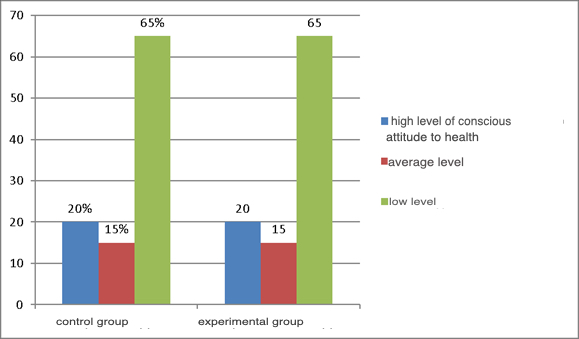
Fig.1 The level of conscious attitude to one's own health (cognitive component) in the control and experimental group of respondents The data obtained indicate that in the control group of respondents, 20% of schoolchildren have a high level of conscious attitude to health, 15% have an average level, 65% have a low level of conscious attitude to their own health. In the experimental group of respondents, the data differ slightly: 20% of schoolchildren have a high level of conscious attitude to their own health, 15% have an average, 65% have a low level. According to the methodology "The level of students' knowledge of cultural norms in the field of health" (the emotional and value component of a responsible attitude to one's own health), the following data were obtained. 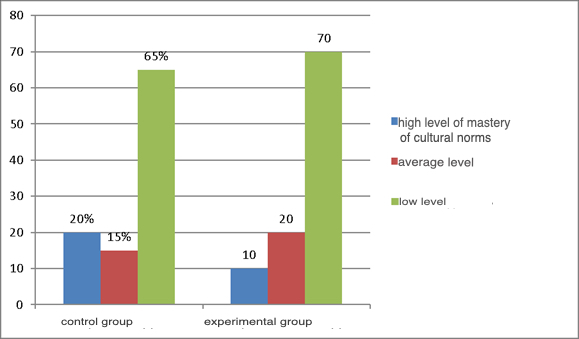
Fig. 2 The level of proficiency in cultural norms (emotional and value component) in the field of health in the control and experimental group of respondents Figure 2 shows that the level of proficiency in cultural norms in the control and experimental groups of respondents is approximately the same. The majority of schoolchildren have a low level of culture in this aspect (65 and 70%, respectively), only a small part of respondents (20 and 10% in the control and experimental groups) have a high level of culture 
Fig. 3 Participation of schoolchildren in health-preserving and promoting a healthy lifestyle activities in the control and experimental groups (activity component) As can be seen from the data presented in Figure 3, the participation of schoolchildren in health-preserving and promoting a healthy lifestyle activities in the control and experimental groups was distributed approximately equally by level. A little more schoolchildren of the control group have a low level of activity – there is no need to lead a healthy lifestyle, passivity in self-improvement and self-realization in the process of acquiring knowledge about human health is manifested (65% - control groups, 45% - experimental). The average level of activity is typical for 15 and 30%, respectively, of the control and experimental groups, the high level is 30 and 25%, respectively. According to the method of "self-assessment of the level of health by students of grades 5-8" authored by E. N. Weiner and E. V. Volynskaya, the following data were obtained:
 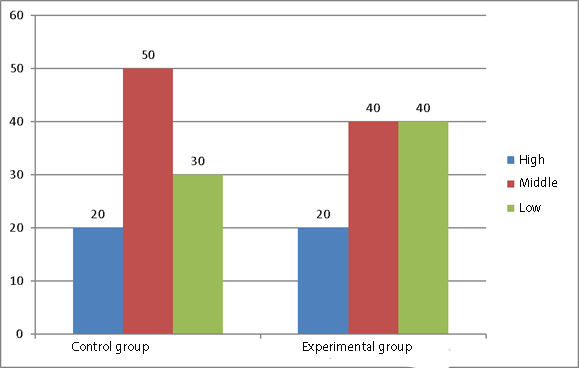
Fig.4 Question 1. Personal significance of health (cognitive component) Figure 4 shows how the answers to the question about the personal importance of health were distributed among the respondents of the control and experimental groups: 50 and 40%, respectively, had insufficient importance of health, 20% of respondents in both groups noted high personal importance of health; 30 and 40%, respectively, had low importance of health. To the next question of the questionnaire, the indicator of which was the assessment of the role of the behavioral factor in the protection and promotion of health, the respondents' answers were distributed as follows (Figure 5). | Assessment of the role of the behavioral factor in the protection and promotion of health | | 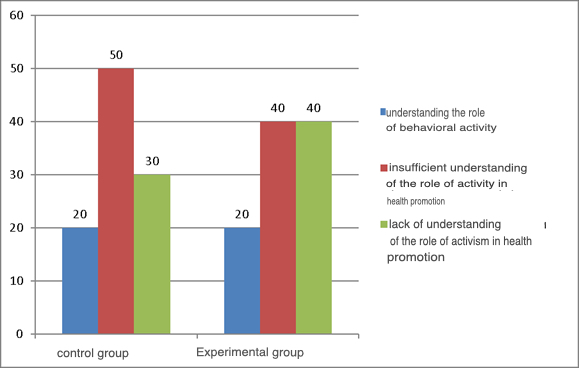
Fig.5 Question 2. Assessment of the role of the behavioral factor in the protection and promotion of health (activity component) When asked about the role of the behavioral factor in the protection and promotion of health, about compliance with the norms and rules of healthy lifestyle, the respondent answered as follows: 20% of schoolchildren understand the importance of behavioral activity in the formation of healthy lifestyle, 50 and 40% of respondents in the control and experimental groups do not sufficiently understand the role of activity in health promotion. To the next question about the compliance of the student's daily routine with the requirements of a healthy lifestyle, the responses of the respondents of the control and experimental groups were distributed as follows (Figure 6) | Compliance of the student's daily routine with the requirements of a healthy lifestyle | | 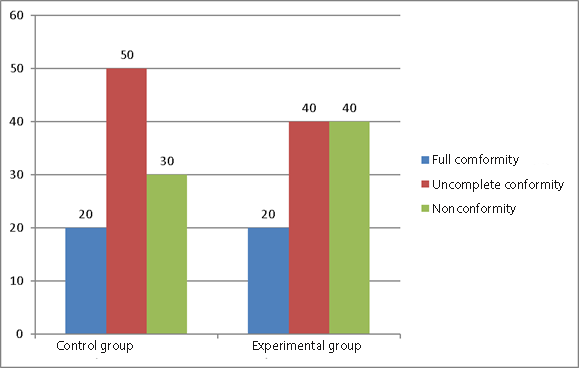
Fig.6. Question 3. Compliance of the student's daily routine with the requirements of a healthy lifestyle (activity component). Thus, the results of the respondents' responses showed that: 20% of the control and experimental group students adhere to the daily routine, 50 and 40%, respectively, do not fully comply with the requirements; 30 and 40% do not fully comply with the requirements of the daily routine. To the next question, which reflects the indicator of the adequacy of students' assessment of their lifestyle and its compliance with healthy lifestyle, respondents answered as follows (Figure 7) | Adequacy of students' assessment of their lifestyle and its compliance with healthy lifestyle | | 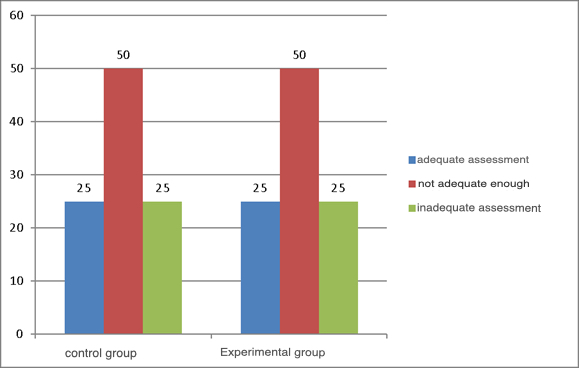
Fig.7. Adequacy of students' assessment of their lifestyle and its compliance with healthy lifestyle (emotional and value component) 25% of respondents in both groups adequately assessed their lifestyle and its compliance with healthy lifestyle, 50% of respondents in both groups did not adequately assess their lifestyle and its compliance with healthy lifestyle by 25% of respondents in the control and experimental groups, respectively. Finally, to the last question of the questionnaire, the indicator of which was the attitude to health-related information, the students answered as follows (Figure 8). | Attitude to health-related information | | 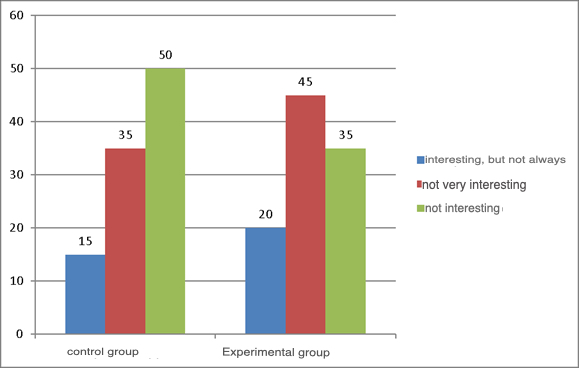
Figure 8 Attitude to health-related information (emotional-value component) Interesting, but not always information about healthy lifestyle is perceived by 15 and 20% of schoolchildren in the control and experimental groups. 35 and 45%, respectively, consider it not very interesting, 50 and 35% - not at all interesting Thus, according to all indicators of attitude to one's own health: cognitive, emotional and value. the majority of schoolchildren do not have a responsible attitude to their own health, which, of course, needs appropriate adjustment and the formation and implementation of psychological and pedagogical programs aimed at forming a conscious and responsible attitude to their own health so that the process of correction, treatment, rehabilitation of such schoolchildren is more effective.
A psychological and pedagogical program for students of grades 4-5 was developed for the formation and development of a responsible attitude to their health and a healthy lifestyle among younger schoolchildren. Within the framework of the program, meetings were held once a week, the purpose of which was the discovery of various knowledge by children regarding a healthy lifestyle, the creation of projects, as well as their trial. When designing classes and the entire work of the program, consultations took place with teachers leading these classes and a physical education teacher in situations concerning physical exertion. The implementation of the program includes three main levels: 1) Emotional involvement ("my health is important to me"); 2) semantic (cognitive) (I understand what a responsible attitude to health is and I know how to take care of my health); activity (I do everything to preserve and strengthen my health). The program itself is a set of classes. Classes are described in the logic of project activity or in the logic of setting an educational task in developmental learning. Each lesson has stages corresponding to the formed level of competencies of schoolchildren: cognitive, emotional, activity. Stages of classes: 1. Motivational stage. At this stage, the general idea is stated, the children actualize the problem that the project is aimed at solving; 2. Planning stage. Students in groups determine the topic, purpose and objectives of the project. An action plan is also drawn up, criteria for evaluating the result and process are established, roles are distributed within the group; 3. Information and operational stage. Work is underway on the content of the project – collecting material, monitoring, product design; 4. Reflexive evaluation stage. Students present their projects, participate in collective discussion and meaningful evaluation of the results and the work process, carry out oral or written self-assessment, the teacher acts as a participant in collective evaluation activities. Classes are arranged in the appropriate thematic logic: 1. Introductory lesson. Healthy lifestyle, rules of healthy lifestyle management. The formation of the norms of the group. 2. The mode of the day. 3. The influence of sports. Learning a set of exercises. 4. Activities that contribute to the transformation of the norm in the group and the transition of the child to a new norm. The description of each of them is designed according to the following scheme: 1. Purpose; 2. Planned results; 3. Required materials; 4. Stages of activity with teacher's tasks and possible answers of children; 5. What result did they come to, how did it affect the functioning of the community and the norm within it. The description of classes in the logic of developmental learning assumes: Acceptance from the teacher or an independent statement of the educational task. "This educational action introduces the problem statement into the system of its solution, which fundamentally distinguishes the educational task from other tasks. Thus, the task of forming the motivational basis for solving the problem is included in the educational task itself and sets the line of formation of motives during the transition from one educational action to another" [46]. It is the fact that the formulation of an educational task and its solution is connected with the motivational basis for performing actions that makes it relevant for a younger student. 1. Transformation of the conditions of the problem in order to detect the universal relation of the studied object. 2. Modeling of the selected relation in the subject, graphic or letter form.
3. Transformation of the relationship model to study its properties in its "pure form". 4. Building a system of particular problems solved in a general way. 5. Control over the implementation of previous actions. 6. Assessment of the assimilation of the general method as a result of solving this educational task. After testing the program, we made a control measurement in the experimental and control group. Classes were held only in the experimental group. In the control group, the children were not exposed. According to the method "Harmony of the lifestyle of schoolchildren" (N.S. Garkusha) – a cognitive component of a responsible attitude to health, the following results were obtained in the control and experimental groups. 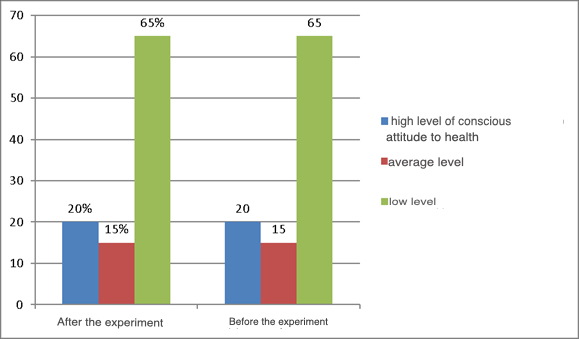
Fig.10 The level of conscious attitude to one's own health in the control group of respondents before and after the experiment (cognitive component) In the control group of respondents, the results did not change according to the method of determining the general level of formation of a schoolboy's health culture authored by N. S. Garkush, consisting of three questionnaires, according to the first of the questionnaires related to determining the level of conscious attitude to one's own health (Figure 11). 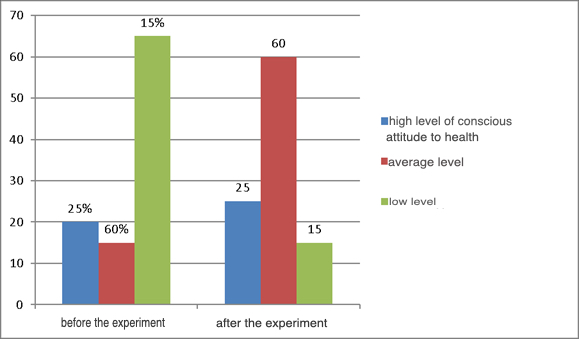
Fig.11 The level of conscious attitude to one's own health in the experimental group of respondents before and after the experiment (cognitive component) In the experimental group of respondents, the number of respondents who were diagnosed with high (from 20 to 25% and average (from 15 to 60%) significantly increased conscious attitude to health, whereas before the experiment, the data differed slightly between the two groups. The number of respondents with a low level has decreased: from 65 to 15%. (figure 13). According to the methodology "The level of students' knowledge of cultural norms in the field of health" (the emotional and value component of a responsible attitude to one's own health), the following data were obtained after the experiment. 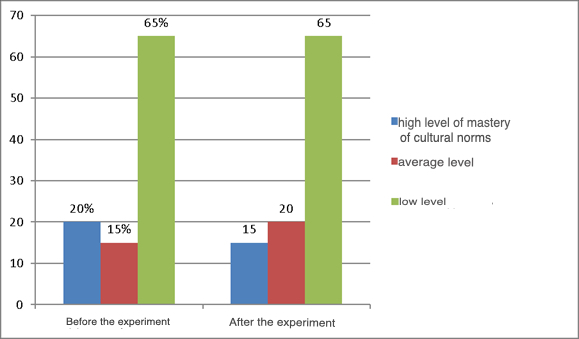
Fig.12 The level of knowledge of cultural norms in the field of health in the control group of respondents before and after the experiment (emotional and value component). In the control group, the indicators of a high and average level of proficiency in cultural norms changed slightly (15% of schoolchildren became characterized by a high level, whereas before the experiment - 20%; the average level – 20%, previously – 15%, the low level remained unchanged – 65% of respondents) (Figure 12). 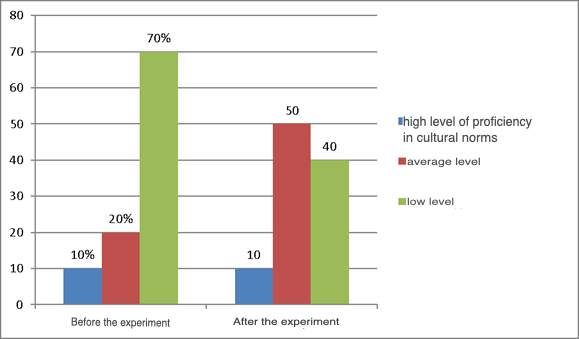
Fig.13 The level of knowledge of cultural norms in the field of health in the experimental group of respondents before and after the experiment (emotional and value component). In the experimental group, the number of respondents with an average level of proficiency in cultural norms increased (from 20 to 50%), the number of respondents with a low level of culture decreased. (Figure 13). Figure 14 shows the indicators of the activity level in the experimental group after the experiment. 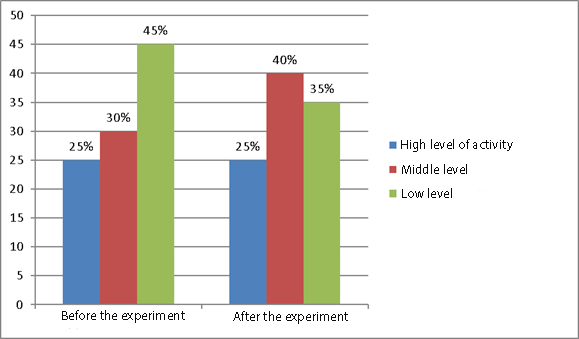
Fig. 14 Participation of schoolchildren in health-preserving and promoting a healthy lifestyle activities in the experimental group before and after the experiment (activity component)
As can be seen from Figure 14, the participation of schoolchildren in health-saving and promoting a healthy lifestyle activities in the experimental group did not increase significantly. The high level remained unchanged, the average level increased from 30 to 40%, the number of respondents with a low level decreased (from 45 to 35%). The indicators of the control group on this issue have become unchanged. The average level of activity is typical for 15 and 30%, respectively, of the control and experimental groups, the high level is 30 and 25%, respectively. According to the method of "self-assessment of the level of health by students of grades 5-8" authored by E. N. Weiner and E. V. Volynskaya, the following data were obtained:  
Fig.15. Personal significance of health in the experimental group before and after the experiment (cognitive component). Figure 15 shows that according to the indicator "personal significance of health", the number of schoolchildren with high significance increased by 10% after the experiment. In the control group on this issue, the results remained at the same level. To the next question of the questionnaire, the indicator of which was the assessment of the role of the behavioral factor in the protection and promotion of health, the responses of the respondents of the experimental group were distributed as follows (Figure 16). | Assessment of the role of the behavioral factor in the protection and promotion of health | | 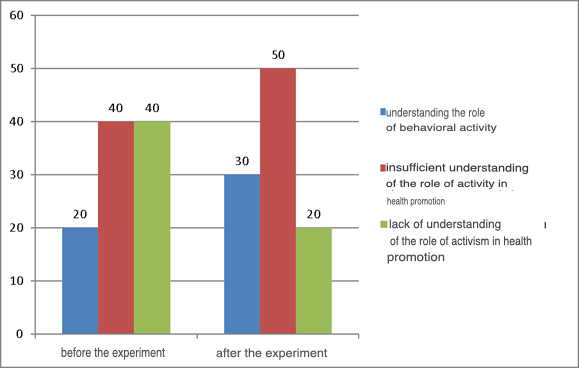
Fig.16 Assessment of the role of the behavioral factor in the protection and promotion of health in the experimental group before and after the experiment (activity component). As can be seen from the diagram, the number of respondents with a conscious understanding of the role of behavioral activity increased by 10%. In the control group, the indicators remained unchanged. To the next question about the compliance of the student's daily routine with the requirements of a healthy lifestyle, the responses of the respondents of the experimental group before and after the experiment also differ (Figure 17) | Compliance of the student's daily routine with the requirements of a healthy lifestyle | | 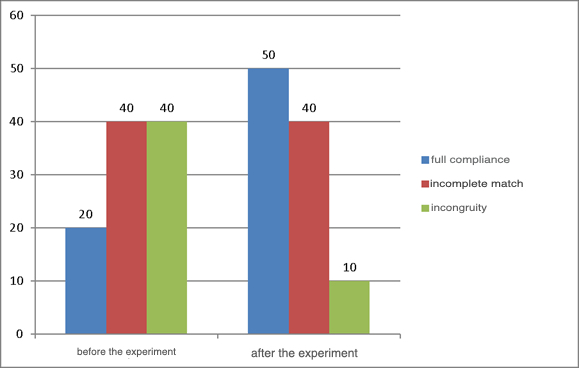
Fig.17. Compliance of the student's daily routine with the requirements of a healthy lifestyle in the experimental group after the experiment (activity component). As can be seen from the diagram, the number of schoolchildren observing the daily routine has increased from 20 to 50 percent according to the criterion of "full compliance". In the control group, the results remained unchanged. To the next question regarding the compliance of lifestyle with the norms of healthy lifestyle, the respondents' answers before and after the experiment did not change in the experimental group. | Adequacy of students' assessment of their lifestyle and its compliance with healthy lifestyle | | 
Fig.18. Adequacy of students' assessment of their lifestyle and its compliance with healthy lifestyle in the experimental group before and after the experiment (emotional and value component). In the control group, the indicators are also unchanged. Finally, the last question of the questionnaire, the indicator of which was the attitude to health-related information, was answered by the students of the experimental groups after the experiment as follows (Figure 19). | Attitude to health-related information | | 
Fig.19 Attitude to health-related information in the experimental group before and after the experiment (emotional-value component). It is noteworthy that after the experiment, the indicators in the experimental group increased, almost all schoolchildren became interested in health-related information To assess the significance of the differences between the observed results before and after the experiment, the Pearson consensus criterion (?2) was used [4]. In the case of this study, it was compared what level of development of a responsible attitude to a healthy lifestyle the child demonstrated by filling out questionnaires during primary and repeated diagnostics. The observation of each of the methods was carried out independently of the observation of the implementation and results of the other method. Table 3 – Statistical processing of general diagnostic results | Factorial feature | Effective feature | The amount | | Low level (less than 60 points) | Average level (60-100 points) | High level (135-100 points) | | Before the experiment | 9 | 15 | 11 | 35 | | After the experiment | 2 | 14 | 19 | 35 |
| Total | 11 | 29 | 30 | 70 | The number of degrees of freedom is 2; The value of the criterion ?2 is 6.622; The critical value of ?2 at the significance level p=0.05 is 5.991; The relationship between factorial and performance characteristics is statistically significant at a significance level of p<0.05. Significance level p=0.037. Based on these data, we can say that after the experiment, classes dedicated to a healthy lifestyle, the number of children showing a high level of responsible attitude to healthy lifestyle has increased. The tables below describe in detail the results of each questionnaire in order to see in which areas there has been a greater change. Table 4 - Statistical processing of the results of the questionnaire "Harmony of the lifestyle of schoolchildren" | Factorial feature | Effective feature | The amount | | Low level (less than 40 points) | Average level (65-45 points) | High level (100-70 points) | | Before the experiment | 10 | 19 | 6 |
35 | | After the experiment | 3 | 11 | 21 | 35 | | Total | 13 | 30 | 27 | 70 | The number of degrees of freedom is 2; The value of the criterion ?2 is 14.236; The critical value of ?2 at the significance level p=0.01 is 9.21; The relationship between factorial and performance characteristics is statistically significant at the significance level p<0.01. The significance level p<0.001. According to these data, it can be judged that younger schoolchildren have a very increased level of understanding of the value and importance of leading a healthy lifestyle. The understanding of what a healthy lifestyle is has increased, and more than half of younger schoolchildren have improved their attitude to a healthy lifestyle. Table 5 - Statistical processing of the results of the questionnaire "Students' proficiency in cultural norms" | Factorial feature | Effective feature | The amount | | Low level (less than 85 points) | Average level (125-90 points) | High level
(160-130 points) | | Before the experiment | 8 | 15 | 12 | 35 | | After the experiment | 1 | 16 | 18 | 35 | | Total | 9 | 31 | 30 | 70 | The number of degrees of freedom is 2; The value of the criterion ?2 is 6.677; The critical value of ?2 at the significance level p=0.05 is 5.991; The relationship between factorial and performance characteristics is statistically significant at a significance level of p<0.05. Significance level p=0.036 Data 2 shows that the developed program has had an impact on whether younger schoolchildren observe the norms inherent in a healthy lifestyle. The results of this questionnaire prove the hypothesis of our research that the development of the program affects a conscious and responsible attitude to lifestyle. That is, 8 out of 10 younger schoolchildren, consciously and responsibly treat their health after the experiment, and only 2 younger schoolchildren do not. Table 6 - Statistical processing of the results of the questionnaire "Participation of schoolchildren in health-saving and promotional activities" | Factorial feature |
Effective feature | The amount | | Low level (less than 40 points) | Average level (50-90 points) | High level (130-100 points) | | Before the experiment | 9 | 11 | 15 | 35 | | After the experiment | 2 | 15 | 18 | 35 | | Total | 11 | 26 | 33 | 70 | The number of degrees of freedom is 2;
The value of the criterion ?2 is 5.343; The critical value of ?2 at the significance level p<0.05 is 5.991; The relationship between factorial and performance characteristics is not statistically significant, the significance level is p>0.05. The significance level is p=0.070. According to the comparative data of this survey, it can be said that the program did not significantly affect the involvement of schoolchildren in school sports events. So, at the beginning of the program, more than half of the younger schoolchildren took part in such events. It can be concluded that the program did not have an impact on the participation of the younger student in health-saving activities. But it is worth noting that the format of participation in these events has changed. If before the program, younger schoolchildren were participants in these events, then after its passage their role in the events changed – they became organizers or helped the teacher in the organization. The data above confirm the hypothesis of the study that the development and implementation of a psychological and pedagogical program for the formation of a responsible attitude to lifestyle, allows t to change the dynamics of a healthy lifestyle, forms a responsible attitude of younger schoolchildren to the conduct of this lifestyle. Based on the results obtained during the study, we can draw the following conclusions: The attitude to health is a system of individual, selective connections of the individual with various phenomena of the surrounding reality that contribute to or, conversely, threaten people's health, as well as a certain assessment of the individual's physical and mental state. The attitude to health is specifically manifested in actions (activity component), experiences (emotional-value component) and verbally realized judgments of people (cognitive component) regarding factors affecting their physical and mental well-being. A psychological and pedagogical program for students of grades 4-5 was developed for the formation and development of a responsible attitude to their health and a healthy lifestyle among younger schoolchildren. The implementation of the program included three main levels: 1) emotional involvement (emotional-value component) ("my health is important to me"); 2) semantic (cognitive component) (I understand what a responsible attitude to health is and I know how to take care of my health); activity level (activity component) (I do everything to preserve and strengthening your health). As a result of the implementation of the psychological and pedagogical program, the level of responsible attitude of children to their health has significantly increased. Namely, the number of children with a conscious attitude to their health (cognitive component) has increased, the level of mastery of cultural norms (emotional and value component) has increased, the number of schoolchildren participating in health-preserving and promoting a healthy lifestyle activities in the experimental group before and after the experiment has increased, more schoolchildren's daily routine has begun to meet the requirements of a healthy lifestyle. To assess the significance of the differences between the observed results before and after the experiment, the Pearson criterion (?2) was used. All differences in these parameters have been confirmed. Thus, the effectiveness of the program was confirmed by statistical data processing.
References
1. Bekhterev, V. M. (1997). Problems of human development and education: Selected. psychol. tr. Moscow.
2. Gulbina, S.N. (2019). Formation of a healthy lifestyle of younger schoolchildren in the classroom and extracurricular time. Bulletin of scientific conferences. Tambov.
3. Guruzhapov V. A. (2019). Prospects for the study of educational activities in the context of the tasks of modern practice of elementary school. Psychological science and education. Moscow.
4. Diagnosing a healthy lifestyle in elementary school. Retrieved from https://znanio.ru/media/diagnostiki-zozh-v-nachalnoj-shkole-2510667
5. Eremin, Yu.S. (2027). Formation of a culture of a healthy lifestyle of younger schoolchildren as a pedagogical problem. Scientific and methodological electronic journal Concept. Moscow.
6. Kapilevich L.V. K (2020). Health and a healthy lifestyle. Tomsk: Publishing House of Tomsk Polytechnic University.
7. Kitaev, V. S. (2021). Conditions and mechanisms for the formation of the need for theoretical knowledge in elementary school. Krasnoyarsk.
8. Lipatova, E.V. (2019). Development of the personality of a younger schoolchild in the process of design and research activities in the classroom and in extracurricular activities. Moscow: Methodist.
9. Oshchepkova, T. L. (2006). Raising the need for a healthy lifestyle in children of primary school age. Moscow.
10. Parfilova, G.G. (2019). Formation of a healthy lifestyle in younger schoolchildren. G.G. Parfilova, S.R. Gataullin (Eds.). Fundamental and applied research: current issues, achievements and innovations. Penza.
11. Perevozchikova, A.V. (2019). Statement of educational problem in the system of developing education D.B. Elkonin - V.V. Davydov in the context of the introduction of a new educational standard in elementary school. Psychological science and education.
12. Sevruk, A. I. (2004). Health-saving lesson. School technologies. Moscow.
13. Sergeeva, B. V. ( 2019) Conditions for the formation of ecological knowledge of junior schoolchildren. Young scientis. Moscow.
14. Sergeeva, B. V. (2019). Means of forming a healthy lifestyle for younger schoolchildren. Problems of Pedagogy. Moscow.
15. Frumin, I. D. (1993). Educational space as a space of development ("school of maturation"). Questions of psychology. Moscow.
16. Carless, D. (2019). Sport and physical activity for mental health. Blackwell Publishing Ltd.
17. Cornell, J. (2015). Sharing nature: nature awareness activities for all ages. J. Cornell, R. Louv (Eds.). Crystal Clarity Publishers.
18. Cutter-Mackenzie A. (2014). Young children's play and environmental education in early childhood education. N-York.
19. Elkonin, B. D. (2019). Occurrence of Action (Notes on the Development of Object-Oriented Action II). Cultural – Historical Psychology. Moscow.
20. Healthy Lifestyle Programs for Primary School. Retrieved from https://www.healthykids.nsw.gov.au/teachers-childcare/healthy-lifestyle-programs-for-primary-schools/nsw-premiers-sporting-challenge.aspx
21. Promoting sport and enhancing health in European Union countries: a police content analysis to support action (2011) WHO Regional Office for Europe.
22. Sport and physical activity: Report. (2019). Special Eurobarometer 412. TNS Opinion & Social, march.
Peer Review
Peer reviewers' evaluations remain confidential and are not disclosed to the public. Only external reviews, authorized for publication by the article's author(s), are made public. Typically, these final reviews are conducted after the manuscript's revision. Adhering to our double-blind review policy, the reviewer's identity is kept confidential.
The list of publisher reviewers can be found here.
The paper "Formation of a responsible attitude to their own health in primary school children" is presented for review. The subject of the study. The object and subject of the study are highlighted by the author in the article. The conducted research demonstrated a developed and tested psychological and pedagogical program for the formation of a responsible attitude to their health for schoolchildren with musculoskeletal disorders. The research methodology is based on the research of B.F. Sergeeva, the activity approach of A.N. Leontiev. Special attention is paid to the study of the components of a person's responsible attitude to health: emotional-value, semantic (cognitive) and activity. The effectiveness and reliability of the conducted research was confirmed statistically, using mathematical data processing before and after the experiment. The relevance of the study is determined by the fact that its insufficient theoretical and practical elaboration determined the choice of the topic of the dissertation research "Formation of a responsible attitude to the own health of children with disorders of the musculoskeletal system in a general education institution." The scientific novelty of the research is as follows. The author highlighted the following provisions: - the concept of "attitude to the health of the subject" and the features of its manifestation in actions and verbally realized judgments are highlighted; - the main levels of the program implementation have been determined; - a psychological and pedagogical program has been developed for students in grades 4-5 to form and develop a responsible attitude to their health and a healthy lifestyle among younger students. Style, structure, content. The style of presentation corresponds to publications of this level. The language of the work is scientific. The structure of the work can be traced intuitively, the author highlights the main semantic parts. In the introduction of the article, the relevance is indicated and the main problems of studying the affected problem are highlighted. The author reviewed the results of scientific research, official data of the Ministry of Health of the Russian Federation, which relate to the health characteristics of primary school children. The analysis made it possible to note that currently the problems of child health need new approaches. As the author notes, special attention should be paid to the educational function of teachers and psychologists, which will allow the child to form an idea of a healthy lifestyle and a setting for a competent approach to their health. The second section is devoted to the degree of elaboration of the problem. The author reviewed the research of domestic and foreign researchers. The analysis made it possible to identify the object, subject and purpose of the study. The next section is devoted to the description of the methods used in the study. The author used a method for determining the general level of formation of a student's health culture by N. S. Garkush, which consists of three questionnaires, as well as a modified method of "Self-assessment of the level of health by students in grades 5-8" (E. N. Weiner and E. V. Volynskaya). The study was conducted over a period of three years. The third section contains a description of the results that were obtained in the study. The data is presented in detail in the description, as well as in the form of diagrams. The conclusion contains detailed conclusions of the study. Bibliography. The bibliography of the article includes 22 domestic and foreign sources, a small part of which have been published in the last three years. The list contains mainly research articles, abstracts and monographs; but Internet sources and textbooks are also presented. The sources are mostly incorrectly designed. Appeal to opponents. Recommendations: 1) describe in more detail the results and prospects of this study, defining the main directions for further study; 2) describe the main provisions of the developed psychological and pedagogical program for the formation of a responsible attitude to their health for schoolchildren with musculoskeletal disorders; 3) correctly issue a bibliographic list. Conclusions. The problems of the article are undoubtedly relevant, theoretical and practical value will be of interest to specialists who consider the peculiarities of forming a responsible attitude to their own health in primary school children. The article can be recommended for publication taking into account the highlighted recommendations.
Link to this article
You can simply select and copy link from below text field.
|



